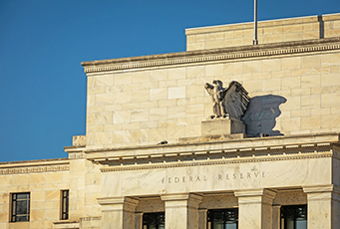How do you measure the overall health of the U.S economy? In 2009, Bedel Financial identified seven key areas that help determine the strength of our economy, and each month, a report is produced called the Bedel Barometer. For the month of December 2021, the Bedel Barometer score is +3.
Using a positive, negative, or neutral score, a value is assigned to each key area and the results are combined to get an overall measure of the economy's health. The range of the monthly scores is -7 to +7. The higher the score falls in this range, the healthier the economy is deemed to be. A negative score is reason for concern. For example, following the Financial Crisis of 2007-2008, the barometer scores were in the negative 3 and 4 range during 2009.
1. Stock Market Performance – Positive since December 2020
The stock market tends to be forward-looking, and it is a leading indicator of economic growth. Domestic and international equities posted negative returns in November. The S&P 500 was down -0.7% in November, while domestic mid and small-cap equities decreased -3.5% and -4.2%, respectively. The S&P 500 is up 1.3% over the last three months and up 27.9% over the previous twelve months.
Global equities pulled back in November as concerns about the Omicron variant, high inflation, and possible accelerated tapering by the Fed scared markets.
2. Consumer Spending – Neutral since April 2021
Over 70% of the U.S. economy is based on personal consumption. Therefore, a reduction in consumer spending will cause slower economic growth. Consumer spending increased 1.3% in October. The second estimate of Q3 2021 consumer spending recorded a 1.7% increase. Personal income increased 0.5% in October. The personal savings rate was 7.3%.
3. Manufacturing Activity – Positive since October 2020
The health of the economy is dependent on the health of the manufacturing sector. Domestic manufacturing activity is tracked by the Institute of Supply Management (ISM), which releases a monthly index. The index monitors employment, production inventories, new orders, and supplier deliveries. The index value ranges between 0 and 100. A value below 50 may indicate a slowdown in the economy, especially if the trend persists over several months. A value above 50 likely indicates a time of economic growth.
IHS Markit produces global Manufacturing PMI (Purchasing Managers’ Index) in association with ISM and the International Federation of Purchasing and Supply Management (IFPSM). IHS Markit compiles it from responses to monthly questionnaires sent to purchasing managers in survey panels in over 40 countries, totaling around 13,500 companies. It has the same value ranges as the ISM manufacturing report.
ISM manufacturing reported 61.1 in November, close to October's reading of 60.8. New orders reported 61.5, up from October's reading of 59.8.
Global PMI posted a reading of 54.2 in November. Of the 30 nations for which November data was available, 26 saw expansion. China, Brazil, Mexico, and Myanmar registered contraction.
4. Consumer Price Stability – Negative since June 2021
Mild inflation is good for the economy because it promotes consumption without destroying the value of people's savings. If you know something will be going up slightly in price down the road, you will be more likely to purchase it now. Deflation, however, punishes an economy because it hurts consumption. If you know something will be cheaper tomorrow or next year, you are more likely to wait until later to buy it. The Fed's inflation target is 2%.
The Consumer Price Index (CPI) increased 0.8% in November. Over the last 12 months, CPI rose 6.8% - the fastest pace in nearly 40 years!
5. Housing Market – Positive since September 2020
The economy typically benefits directly and indirectly from increased housing activity. It is estimated that for every $100 in value resulting from housing construction, an extra $40-$80 is added to the economy due to housing-related spending.
Total existing-home sales increased 0.8% in October to a seasonally adjusted annualized rate of 6.34 million units. However, sales in total decreased -5.8% from a year ago. In October, the median existing-home price was $353,900, up 13.1% from October 2020. This marks 116 straight months of year-over-year gains. Unsold inventory is at about a 2.4-month supply. A three to six-month supply is considered a healthy balance between supply and demand.
New home sales increased 0.4% in October. The median sale price of new houses sold in October was $407,700. Unsold inventory is at about a 6.3-month supply. Note that the new home sales report is volatile, and the data is frequently revised.
6. Volatility – Neutral
VIX is the symbol for the Chicago Board Options Exchange's volatility index. It's a weighted mix of the prices for a blend of S&P 500 Index options, from which implied volatility is derived. In other words, it measures how much people are willing to pay to buy or sell the S&P 500. The VIX goes up when there's turmoil in the market and goes down when investors are content or at ease with the economic outlook. We like to watch the VIX because it measures the cost of buying insurance for stock protection (through options). When the cost of protection is high, volatility is usually high, and the potential for declining stock values is higher.
The VIX closed at 27.2 to end the month of November—above the historical average of around 19.2. The VIX started the month in the mid-teens and quickly increased toward the end of the month as the market became more volatile.
7. TED Spread – Positive since June 2020
The TED Spread is the banks' cost of borrowing short-term money minus the Treasury's cost of borrowing short-term money. When the spread is significant, banks worry about being repaid when loaning money to other banks, creating uncertainty. This can cause slower growth in the economy.
At the end of November, the spread was 0.11%. There was a slight increase from October's spread of 0.08%. The current TED spread of 0.11% is below the historical average spread of about 0.57%.
Summary
While past performance is not a guarantee of future results, the current score for the Bedel Barometer is +3. Economic metrics are continuing to improve with the slow reopening of the economy. If you would like to receive monthly updates from our Bedel Barometer, please sign up at BedelFinancial.com/Blog.
BEDEL BAROMETER
Last updated December 2025
Past performance is not a guarantee of future results. As of December 20, 2021 the current score for the Bedel Barometer is +3. Economic metrics are continuing to improve with the slow reopening of the economy.
Schedule a Consultation
We have helped our clients answer these questions and more. If you want a clear understanding of your financial future, and need help making changes to reach your goals, schedule a consultation and we can get started.
Recommended Articles
Private Equity and M&A in a Low-Rate World
Deal flow is the stream of business proposals, investment...





